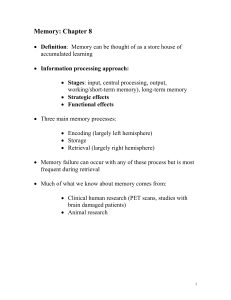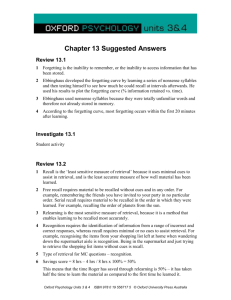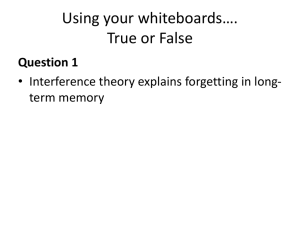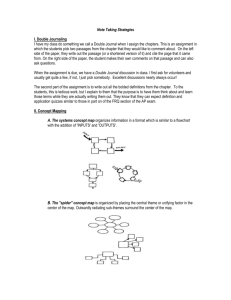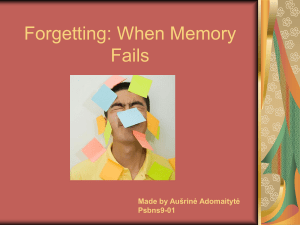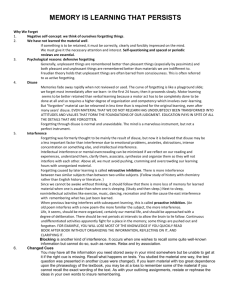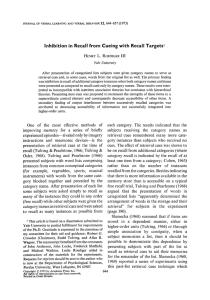View
advertisement
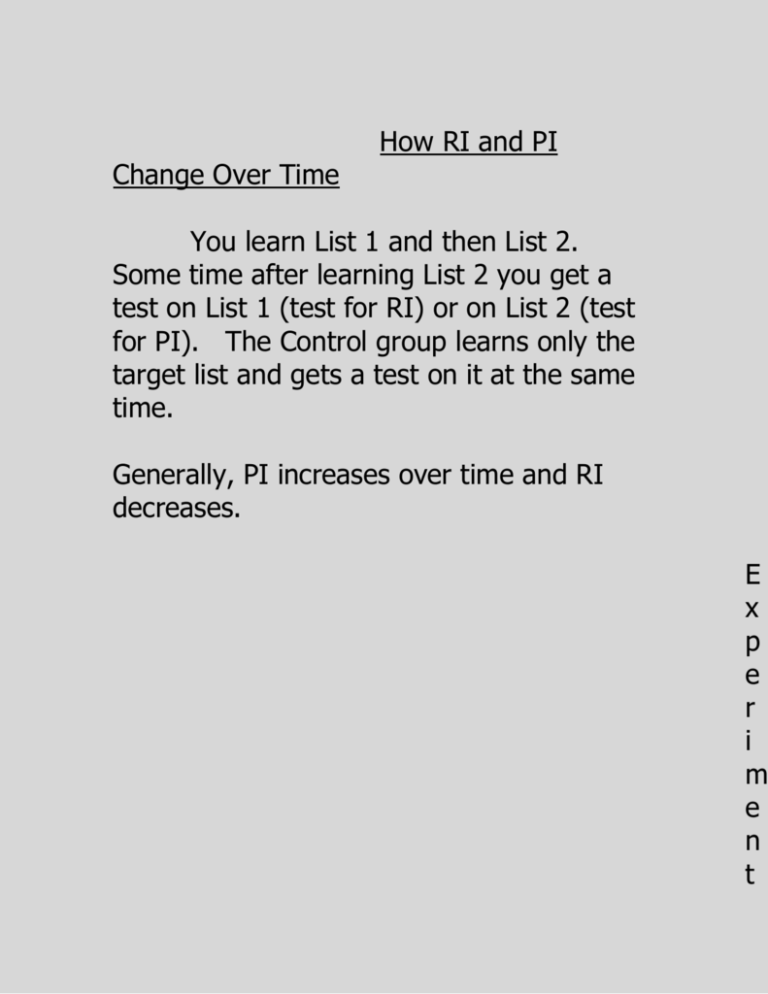
How RI and PI Change Over Time You learn List 1 and then List 2. Some time after learning List 2 you get a test on List 1 (test for RI) or on List 2 (test for PI). The Control group learns only the target list and gets a test on it at the same time. Generally, PI increases over time and RI decreases. E x p e r i m e n t a l C o n t r o l PI Number of Items Recalled from List 2 PI 0 24 Retention Interval in Hours (Time Since Learning List 2) RI Predicted by 2-Factor Theory Number of Items Recalled from List 1 RI RI 0 24 Retention Interval in Hours (Time Since Learning List 2) Release from Proactive Interference As you increase similarity between target and interfering information, interference increases. Similarity can be conceptual, words from same conceptual category. Wickens (1972): Peterson & Peterson task but subjects get 3 words instead of 3 letters. Recall tested 15 seconds after presentation. Control group gets words from the same conceptual category (fruits) on each of 4 trials. Experimental group gets the same on Trials 1 – 3 but then gets switched to professions on Trial 4. A decrease in recall across trials showed the buildup of PI due to similarity to previous items. An increase on Trial 4 in the Experimental group showed release from PI because there was less interference between the dissimilar items. Control: Names of fruits on all 4 trials Experimental: Fruits on trials 1 – 3, then names of professions on Trial 4 100 80 Percent Correct Recall 60 40 20 0 1 3 2 4 Trial Amazingly, if you shift to vegetables or flowers on Trial 4, there is a smaller increase because they are more similar to fruits, so there is more PI. Everything fits together very neatly. Cue-Dependent Forgetting This theory, like interference theory, says that forgetting from long-term memory is the result of retrieval failure. Target information may be located in memory and retrieved if we are presented with retrieval cues. A retrieval cue is any stimulus, either external or internal, that helps us recall stored information. It can be anything we see, hear, smell, or touch. It can be any internal event that we sense—an emotion, a mental picture, a thought, a sensation, or a physiological state. The most effective retrieval cues are stimuli that were present during original learning. They are “packaged” with the target information and the whole package gets stored in long-term memory. If you can remember some of these cues, it’s like getting your fingers around part of the package, and it’s easier to bring the target information to mind. The encoding specificity principle states that information is learned (encoded) in terms of the specific situation in which learning took place. The situation is defined by both internal and external stimuli (cues). Having a lot of these cues present during recall increases the chances of recalling the target information. This cognitive principle is similar to the behavioral principle of stimulus generalization: When a response is conditioned to a stimulus, that response will also tend to occur to similar stimuli. The greater the similarity, the more likely it is that the response will occur. What’s different about the encoding specificity principle is that it talks about mental events (images, thoughts) as part of the stimulus context. So it represents a blend of the cognitive and behavioral traditions. Comparing Interference Theory and the Theory of CueDependent Forgetting Look at the diagram of the experimental design for studying RI. To explain forgetting, interference theory focuses on Phases 1 and 2. It asks how similar the target information (Phase 1) is to the interfering information (Phase 2). Cuedependent forgetting looks at Phases 1 (learning List 1) and 3 (test on List 1) and asks how similar are those two situations. The 2-factor theory of interference explained RI in terms of response competition and extinction. These processes did not provide a satisfactory explanation. In contrast, cue-dependent forgetting and the encoding specificity principle can explain at least some cases of RI. Tulving & Psotka (1971) showed that cue-dependent forgetting can produce RI. Experiment by Tulving & Psotka Each list consisted of 24 nouns from 6 conceptual categories, 4 words per category. Words within a category appeared one after the other, 1 second per word, without the name of the category being shown. For example, hut, cottage, tent, hotel, cliff, river, hill, volcano, captain, corporal, sergeant, colonel, ant, wasp, beetle, mosquito. The categories in this example are: dwellings, earth formations, military titles, and insects. Each list was shown 3 times. It was assumed that subjects would notice the categories and store together the words within a category. Immediately after the 3rd presentation, there was a free recall test on the list in which subjects were asked to write the words in any order. For the Control Group, there was then a 10 minute distraction task followed by a second free recall test. For the Experimental Group, there were 1 or more additional lists. The group was subdivided according to how many additional lists were presented: 1, 2, 3, 4, or 5. Then they got a test on List 1. If they scored lower than the Control Group on List 1, this would indicate that the additional lists caused RI when the subjects attempted to recall List 1. Results of Delayed Test Words RI Categories (Control – Exp) Words per Category 100 Percent Recall 50 0 0 3 4 1 2 5 (Control) Number of Additional Lists Definitions Category: a category was said to be recalled if at least one word from that category was recalled. Words per category: if at at least 1 word from a category was recalled, this was the percent of all 4 words that was recalled. Interpretation As the number of additional lists increased, the amount of RI increased, as indicated by the Experimental Group’s decrease in the number of words recalled. The number of categories recalled (as defined above) also decreased. However, the words/category measure remained at a high constant level and showed no evidence of RI. If they could remember 1 word from a category, they could usually remember all of the words from that category. This shows that RI resulted from an inability to remember categories. The link between categories and the words within those categories remained intact. So if a way could be found to help subjects remember the categories, they should remember most of words on the list, and RI would be eliminated. Test of This Interpretation The Control and Experimental groups were given a second “cued” recall test in which the names of the categories appeared on the answer sheets, for example, DWELLINGS _____ _____ _____ _____ EARTH FORMATIONS _____ _____ _____ _____ The category names were expected to act as retrieval cues for the words that belonged to those categories. IF RI results from losing access to the names of the categories, then RI should be eliminated. This prediction was supported. Recall of List 1 (Out of 24) Number of Additional Lists Recall Cued Recall Uncued 0 16.6 1 12.1 2 9.4 3 7.1 4 6.6 5 6.8 18.1 20.5 16.4 15.4 16.2 16.1 The differences between the Experimental Groups and Control Group (0 additional lists) were not significant, so presenting the retrieval cues eliminated RI. General Conclusion You can protect yourself from interference by self-administering retrieval cues through the use of mnemonics. Mnemonics associate target information with cues during learning and provide a means of reactiviating those cues during recall, which reduces cue-dependent forgetting.


